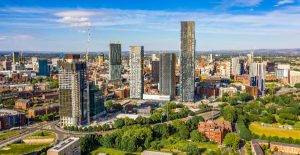The city centre of Manchester is fairly small given the cities stature, but the entire city is much bigger than it seems. Manchester is 115.6 km²; making it bigger than Liverpool, but less than half the size of Birmingham. It is the 6th largest city in the UK and had an estimated population of 530,300 back in 2016.
But that’s to say nothing of what you can actually do in Manchester! Some of the most popular areas include the Gay Village, Oxford Street, and Spinningfields. The history of this metropolis is long, dating back to 80 CE; read all about it below in our historical information section, before you more on to the more entertaining section of this article to learn about the wonders that exist in Manchester today.

Image: zaeball/Shutterstock.com
History of Manchester!
When a wooden fort was built by the Roman army in 80 CE, Manchester’s history began. The Romans called that fort “Mamucium”, and it was rebuilt in stone around 200 CE. Quite soon after its construction, a civilian settlement grew into existence around the fort. The soldiers of the army provided a market for the civilians so that they could sell their goods to each other and other visitors in the area. However, the stone fort fell into ruins once the army and civilians left during the time of 407 CE.
In 1086, a small village by the name of “Mamecester” was noted to exist. Several years before, in 919, the King repaired the fort, bringing life back to the area; even as the fort was used to defend them. By the late 11th century, Mamecester had become Manchester; a small village of Normans.
Trade grew in England, new towns popped up everywhere, commerce grew at a rapid pace, and Manchester was soon named a town in the early 13th century and given the right to hold an annual fair. The wool and leather industries were the biggest in Manchester at the time (and well into the 17th century!), with wool being dyed and leather being tanned daily.
Chetham’s Hospital, a school for poor children, was founded in 1656; St Ann’s Church was built in 1712; and in 1761, the Bridgewater canal was built to bring coal to Manchester. But the developments of Manchester didn’t stop there!
The Royal Institution for the promotion of Literature, Science and the Arts was built in 1829; and made into an art gallery in 1882. A Natural History Museum opened in Manchester in 1835. Just eleven years later, in 1846, the first public parks opened.
And finally, in 1853, Manchester was made a city. No longer a town, more and more people flocked to the city in search of new developments and an evolving way of life. Cemented by the technical school that was built in the city at the latter end of the 19th century.
The 20th century brought more industries to the city, including tourism. The 21st century has seen Manchester turn itself into a city of transport. Roads through the city double as tram lines, there are buses on practically every corner, and the airport can be so easily accessed from the main train station of the city.
What to do in Manchester!
There is so much to do in Manchester that your head may spin! The best thing about Manchester is how easy it is to get around. You can easily walk from one side of the city centre to the other in about 40 minutes; or you can just catch one of the many city-crossing trams that come your way.
Visit John Rylands Library and see the wonders of the gold-toned architecture there. Once you’re done there, you’re just a short hop away from Manchester Central Library, where you’ll be about to seek out the city’s famous worker bee symbol in the area.
Don’t just take our word for the sights of Manchester; check out the sections below for your own weekend break ideas! We’re sure that you’ll find something new to love in this thriving transport-friendly city.
Shopping
Arndale is probably the one shopping centre in Manchester that everyone knows about. It’s right in the city centre, just minutes away from Manchester Piccadilly station, and it’s absolutely humongous! This indoor shopping mall contains every big high street store you can name off the top of your head, as well as a bunch of eateries that are great for grabbing a quick bite while you’re shopping.
King Street is the place of designers, while Cross Street will give you Selfridges and the Triangle Shopping Centre; home to special and unique brands and boutiques. The Northern Quarter, however, is a quirkier place; full of vintage shops, record stores, and old and new book shops.
The Trafford Centre is known about as well as Arndale Shopping Centre, though it exists on the outskirts of Manchester. It has hundreds of shops and restaurants inside its doors, from John Lewis to Dr Martens. There’s also an indoor cruise ship in the centre, which has a starry sky; pretty impressive if you ask us.
Food and Drink
Anywhere in Manchester that there is a place to shop, there are also places to eat. There’s a café, bar, or restaurant on every street; to the point where the choice is almost overwhelming. Check out our guide below for some of the best restaurants and friendliest cafés to go to in Manchester:
Mr Cooper’s combined modern cuisine with the owner’s own family history. European dishes with a flair, cooked with unique techniques – there’s no reason not to book a table to share with your partner if you’re looking to impress. Located in Spinningfields, just a couple of streets away from the Odeon cinema.
Looking for somewhere to have afternoon tea? The Tea Room at The Midland Hotel brings a timeless atmosphere to your table. Each set of afternoon tea is served with the hotel’s own brand of elegance, right down to the delicate finger sandwiches available for you to eat. The tea room is its own section of the hotel, offering plush chairs for a lavish lunchtime. If you would prefer somewhere closer to the city centre, Level 3 at Mercure in Manchester is on Portland Street – just 2 minutes away from Manchester Centre.
Buffet City is a restaurant for large groups, parties, and the hungry who don’t know what they want to eat. Over 60 Asian dishes are available from the buffet, including a sushi bar. This restaurant is also on Portland Street.
As for cafés, well, did you know that there’s a cat café in Manchester? Easily locatable on High Street, quite close to the rear exits of the Arndale Shopping Centre, this friendly café has quite a few furry friends who will happily entertain you for a time. Price is paid per hour and includes unlimited drinks!
Music and Entertainment
Manchester can be great for a night out in the city, with clubs and music venues open until late, and trains running as late as 11pm at night; it has a London vibe on a smaller scale. Band on the Wall has been a cornerstone of Manchester’s music scene since its conception, whereas Albert Hall runs out of a Grade II listed chapel-turned-venue. If those two aren’t enough to tell you how diverse the music scene is in Manchester, we’re not sure what else would convince you.
Entertainment-wise, shopping is obviously one great way to keep yourself from getting bored. But if you don’t fancy spending a few hundred pounds on new clothes, shoes, and accessories, then try one of these activities on for size:
Take a Cantonese Cookery Class at Yang Sing on Princess Street in Greater Manchester. For just £80 per person, you get a class that is 2-3 hours long, and it covers how to make and cook dim sum, as well as how to properly utilise a wok.
Enjoy a mountain excursion on your longer Manchester stays. There’s a tour to the Lake District that starts at Manchester and takes guests to Windermere. It’s £48 per person and runs on Mondays, Wednesdays, and Saturdays. It takes approximately two hours to get to Windermere from Manchester, but it’s definitely worth it if you want a day out of the city while you’re in the area. Tours are run through the Mountain Goat company.
For fans of history, there are plenty of walking tours in Manchester. In fact, there is an organisation that trains individuals who have been affected by homelessness to give the tours; Invisible Cities, tour guides with a difference. These individuals know the city inside-out, and they’ll be sure to give an informative and fun tour.
Travelling in Manchester!
We mentioned at the beginning of this article that Manchester was a city of transport. Until you get there, you won’t believe how much that statement suits the city, but to give you an idea, we’ve put together a quick guide to getting around Manchester city.
Transport for Greater Manchester is the official company in charge of the fleets of buses, trams, and trains that take over the streets and rails of this amazing city but planning your journey can be confusing. Luckily, the company has their own website that can help you with journey planning, and there are information kiosks in the train stations, as well as guides at tram stops.
Let’s start with the free bus. Once called the Metroshuttle, this free bus has a simple hop-on, hop-off service. It links all of the major train stations with the shopping districts and the business locations in the city. The service operates on a circular route. The first, most notable stop is right outside Manchester Piccadilly Station as soon as you exit the main doors.
Now, the commercial buses are a tad different. There are well over 100 different bus routes going everywhere and anywhere in and around Manchester. An all-day any-bus ticket for an adult is £5.80 and can be used until 4am the next morning from the date of purchase.
There are so many travelcard options that it’s best to buy online to make sure you’re getting the right one. There are just bus travelcards, bus and tram, bus and train, train and tram, and bus-tram-train ones. You can buy one-day, one-week, 28-day, and annual travelcards, too! These are purchased through the System One Travel website.
As for trams, they can be cheaper or more expensive than buses, depending on the time of day you’re travelling, which zone you need to travel it, and whether you just need a single, a return, or a day ticket. For example, travelling anytime during the day in all zones is £7, but the same needs during off-peak hours lowers that to £4.80; making it cheaper than travelling by bus.
Finally, there’s the rail network. Connecting Greater Manchester to many of its neighbouring towns; including Stockport, Wigan, and Oldham, among others.
Places to stay in Manchester!
There are over 300 hotels, hostels, and B&Bs in Manchester and its surrounding areas. That’s not counting any Air BnBs, of which there are many more. Directly in the centre of Greater Manchester, in the city centre, you’ll find about 100+ of those. Prices range from £30 to £150 a night, depending on the place you’re staying.
Right next to Victoria Station, you’ll find the 4-star Hotel Indigo for around £63 a night. A Victorian building that is elegant, refined, and has a cocktail bar near it’s 24-hour gym. At the time of writing, this hotel has over 350 reviews on Google, with an average rating of 4.7 stars.
If you’re looking to stay nearer to Manchester Piccadilly Station and the Northern Quarter, there is a Hotel Ibis for £65 a night, or a Travelodge for around £36 a night (right next to Wetherspoons).
As for Air BnBs, you can stay in everything from an apartment to a narrowboat in this city. The world is truly your oyster when it comes to accommodation in Greater Manchester! (That narrowboat is £49 a night, in case you’re interested.)



